Hispanic Heritage Month: Ancient Art
If you ever study the history of ancient Central and South America, you will immediately become, as I have, completely enthralled with the history of our hemisphere. For the variety of incredibly sophisticated and beautiful art forms, the cultures of these regions rival anything fans of ancient Roman or Greek history (the “zenith of Western art and culture”) can throw at them and pass the challenge with flying colors. Here are some examples of the rich variety of that art.
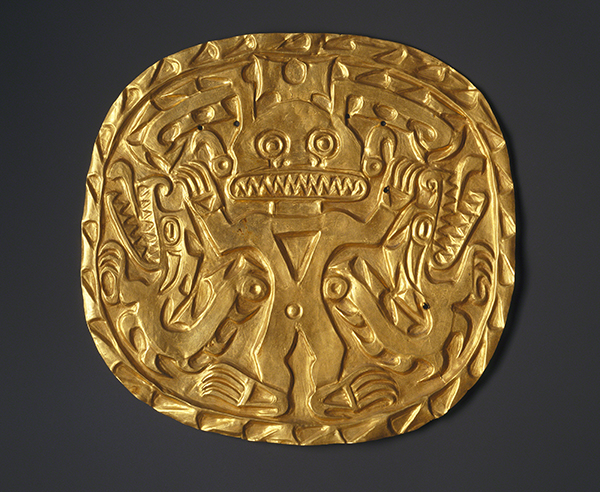 |
| Coclé Region Culture, Panama, Plaque with image of Crocodile God, from Sitio Conte, ca. 700–900 CE. Hammered gold, 8 ½" x 9" (21.6 x 22.9 cm). © 2020 Brooklyn Museum. (BMA-4895) |
Until the introduction of maize by 1500 BCE, Panamanian native groups were primarily hunters and fishers, grouped in small settlements along the coast. Even before that period, tools were sophisticated with the use of grinding stones and axes. The introduction of maize precipitated larger villages, which appeared first on the western coastal region, and the development of ceramics.
By 300 BCE, there was a diffusion of large maize-cultivation villages, which developed into larger ceremonial centers with public architecture by 500 CE, much on a par with other regions of Mesoamerica. Bichrome and polychrome pottery with zoomorphic and geometric motifs appeared. There was increasing stratification of society, indicated by mass burials around single individuals whose graves included many luxury items. By the time of the arrival of the Spanish invaders in the 1500s, the chiefdom societies were well established.
The working of gold into ornaments and luxury objects in Mesoamerican and South American cultures spans a period of from 1500 BCE to 1500 CE. These cultures produced gold objects at overlapping dates, all making reverence to the metal itself; gold was the "sweat of the sun."
Craftsmanship in gold was a highly valued artistic skill in all of these cultures, the artists being housed in compounds within ceremonial center precincts. With the later Colombian cultures of the Zenu and the Muisca, between 500 CE and 900 CE gold tradition moved steadily north to Panama and ultimately Costa Rica. Panamanian gold artists produced a wide variety of objects in lost wax casting, repoussé, and filigree techniques.
This pectoral (chest plaque) excavated from Sitio Conte comes from the grave of a dignitary. The Sitio Conte graves were known for their large caches of gold objects. The zoomorphic figure with bird claws and iguana headdress depicts The Crocodile God, chief deity in Panamanian religion. The god represented strength, the sun and water, and fertility. Reptiles and the gleam of gold linked the elite to the sun as the source of all life (and afterlife). The ruling elite probably wore prestige ornaments like this example in order to appropriate the power of crocodiles, connected to the underworld because they float on water and drag their prey below to drown it. It may also represent a transformative image of the deceased.
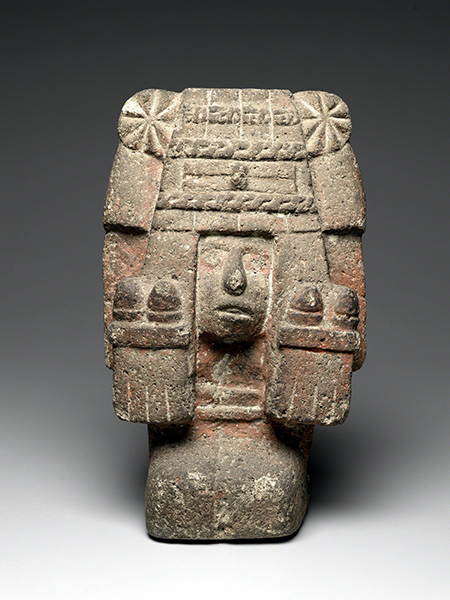 |
| Aztec Culture, Mexico, Seated Chicomecoatl (corn goddess), ca. 1440–1521. Stone, 15 1/2" x 9 1/2" x 6 1/4" (39.4 x 24.1 x 15.9 cm). © 2020 Brooklyn Museum. (BMA-1669) |
Throughout Mesoamerica, the great cultures of the Classic period (ca. 250–600 CE)—the Maya, Teotihuacán, and the Zapotecs—all disintegrated between the Late Classic (ca. 600–900 CE) and Post-Classic (900–1300 CE) period. The Zapotecs, centered in the city of Monte Alban in Oaxaca, were supplanted by the Mixtecs in the 800s CE. The Mixtec created a strong, wealthy culture and were skilled in sculpture, ceramics, and goldsmithing. The Mixtec warred constantly with one another and neighboring cultures, and only once in their history were united under one ruler. Between the 1300s and 1500s, many Mixtec city states paid tribute to the Aztec kingdom.
The Aztec from the northern Mexican plateau seem to have migrated south during the 900s CE. By at least the 1100s, they were in the region of Teotihuacán, a great city state that flourished 30 miles northeast of Mexico City between 200 and 900 CE. They were also in contact with the Toltec, who had power in Mayan lands from the 900s onward. The name Aztec is derived from the mythical distant area of Aztlan, a place where many central Mexican cultures claim origin.
The Aztec called themselves Mexica, from which Mexico is derived. Settling on Lake Texcoco in 1325, they founded Tenochtitlan, present-day Mexico City. They aggressively built a steadily expanding empire through trade and warfare until the arrival of the Spanish conquerors in the 1500s.
The Aztec worshipped a pantheon of deities, many of them extending back through several other cultures in Mexico. Chicomecoatl was one of these gods. Called "Seven Snakes" (because of the auspicious nature of the number seven in Aztec numerology) and sometimes "Young Maize-Ear Doll," Chicomecoatl was the god of sustenance, hence Mesoamerican cultures' most important crop, corn (maize). She was the female counterpart to the corn god Centéotl.
Aztec sculpture was monumental in form and less animated than that of many of the Mayan cultures. But, like other Mesoamerican cultures, Aztec sculpture used a decorative type of stylization for natural forms that were symbols for gods. Chicomecoatl is most often depicted like this with the amacalli (“paper house”) style headdress and clutching two ears of corn in each hand.
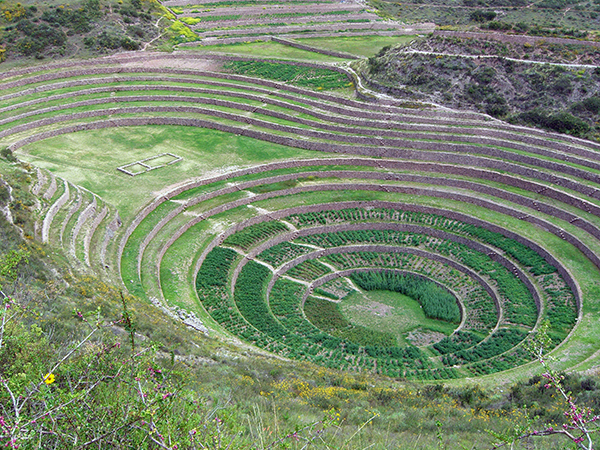 |
| Inka Culture, Peru, Agricultural Platforms, Moray Valley near Cuzco, ca. 1438–1533. Photo by Philipp Weigell. CC BY 3.0. (8S-30019) |
By the time of the Spanish invasions, Peruvian civilization had thrived for centuries and had reached a high level of sophistication. Gold had been recovered from deposits in Andean rivers from as early as 1200 BCE. In a succession of civilizations beginning with that of the Chavín, the goldsmith's skill developed over 2,500 years to its high point during the Chimú Empire.
The Inka were a small highland culture who established their rule (ca. 1100) in the valley of Cuzco. The city of Cuzco was their capital. By 1350, they had extended their control beyond the Cuzco valley to all of the areas close to Lake Titicaca in the south as well as the valleys immediately east of Cuzco. They also extended their control northward to the Upper Urubamba River. By 1450, their empire stretched from Quito in present-day Ecuador to central Chile, a territory of 3000 miles.
The Inka culture left behind impressive cities and fortresses built of incredibly precisely cut stones. Characteristic of sites such as Machu Picchu are stepped terraces walled in with masonry. Many of these terraces were meant for agriculture, suited to the rough terrain of the location high in the Andes.
Stepped terraces also characterized the agricultural site of Moray Cuzco, or Qechuyoq, northwest of Cuzco, in the Moray Valley. The Moray platforms, built into the natural depressions, are 492 feet (150 meters) deep in the main ring, with an average height of almost 6 feet (180 cm). The concentric terraces produced a number of microclimates, higher in the center rings and gradually lower toward the outer ring.
According to scientific studies, a number of types of crops were sewn on these terraces. The Inka were able to grow more than 250 different types of vegetables. Some scholars believe that Moray was also used as an astronomical observation location. "Moray" may derive from the Qechua (the Inka language) term for corn, aymoray, or for dried potato, which is moraya.
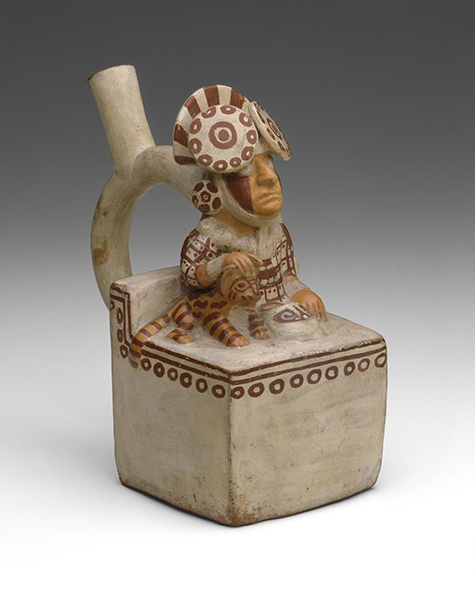 |
| Moche Culture, Peru, Seated Ruler with Pampas Cat, stirrup-spouted vessel, 250–550 CE. Slip painted ceramic, 7 5/8" x 7 ½" (19.4 x 19.1 cm). © 2020 Art Institute of Chicago. (A8039) |
The Moche culture developed along the desert plain of northern Peru. They were centered in several valleys: Lambayeque, Jequetepeque, Chicama, Moche, Virú, Chao, Santa, and Nepena. Through a sophisticated network of irrigation channels and aqueducts, the Moche maintained control over fresh water, a rare achievement at the time. It was the fertile land of the Moche that nurtured the clay that evinced a valuable art form, ceramics.
The Moche culture was theocratic (ruled by religion) with a hierarchy of priest-ruler-warriors, nobles, and artists at the top of the social ladder. However, there are Moche ceramics that depict every station of life in Moche society, along with plants, animals, and mythological figures.
These ceramics were not whimsical and always realistic. They were typically built in the coil method (although square examples were probably built in the slab method) with the stirrup handle (so-named after a stirrup on a saddle) fused to the body with slip. Non-portrait vessels were usually formed in a mold. Typically, the ceramics are tricolor in pigments of white, red, and black.
This vessel depicts a noble or ruler, as evidenced by elaborate headdress (minus the stirrup, of course) embellished with feathered ornament and tell-tale makeup on the face. Moche ceramic artists preferred flat-based vessels. Portrait vessels are inevitably one-of-a-kind portraits of a real person as a model, though not necessarily the person in whose tomb they were placed, probably produced from molds that were modeled on one particular person, among the earliest in ceramic history.
The sophistication of molding and particular detail rival ancient Greek ceramics of roughly the same period. The cat in Andean cultures was considered an intermediary between the spirit and human world, and cats acted as protectors of rulers. Such portrait vessels were included in tombs, often bearing some sort of food offering for the next world. Such vessels were obviously status symbols.
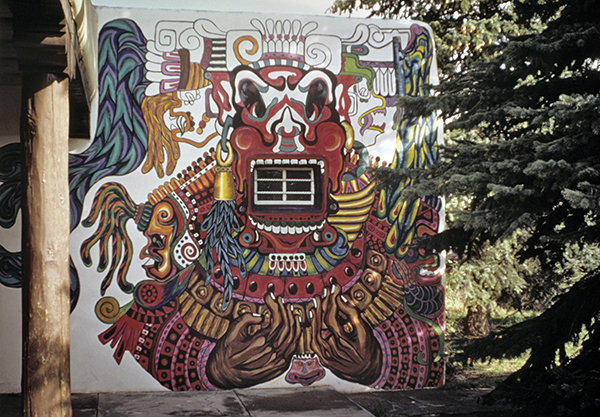 |
| Artes Guadalupaños de Aztlán (active 1971–1977, Santa Fe, New Mexico), Huizitlopochtli, mural on the Clinica de la Gente, Santa Fe, NM, 1973. Image: Davis Art Images. (8S-20371) |
In case you have any doubt that the heritage of Central and South American ancient cultures has endured to the present day, all one has to do is look at the influences of that ancient art in contemporary Latinx artists. The influence of ancient Central and South American art began appearing in 1900s artists’ works throughout the hemisphere, particularly in the Mexican Mural Movement that developed in the 1920s. This became a bridge to the art of now. This influence became considerably stronger in contemporary Latinx art starting in the 1960s, encouraged by the Latinx mural movement in cities all over the U.S.
The mural movement in the U.S. in the late 1960s and early 70s was influenced by the post-Mexican Revolution Mexican Mural Movement of 50 years earlier. The goal of the American public art movement was to vocalize social and political concerns pictorially, enhance depressed neighborhoods with beautiful art, and empower the members of those communities by encouraging their participation in mural projects. It has been variously called contemporary mural renaissance, people's art, or simply street art, and produced hundreds of large-scale wall paintings in a dozen major U.S. cities and in Canada.
The Mexican American Movement arose at the same time as the Civil Rights Movement for African Americans. It grew partly from the success of the organization of the United Farmworkers of America in 1962 and continued into the late 1960s, increasingly focused on the injustices and inequality in American society for a variety of minority groups, including Latinx Americans.
Artes Guadalupanos de Aztlán was founded by three artist brothers (Samuel, Albert, and Carlos Leyba) in Santa Fe, New Mexico, whose fourth artist brother George had died of a heroin overdose, a common problem in the Latinx community at the time.
Many of the murals of Artes Guadalupanos de Aztlán reflect the "Brown Power" movement, and its efforts to educate and uplift Latinx, much in the way the murals of Diego Rivera (1886–1957) and other Mexican artists had done in Mexico after the Mexican Revolution (1910–1917).
This unfinished mural represents the Aztec god Huitzilopochtli (huitzilin: “hummingbird”; and opochtli: "left"), the deity of war, sun, and human sacrifice. Warriors were believed to be reincarnated as hummingbirds that came forth from the south, the "left side" of the world, or the land of the dead. One of the ways the god is depicted is seen here: a warrior in armor and helmet made of hummingbird feathers.
The complexity of this mural reflects the complex figures of deities seen in Mesoamerican illustrated manuscripts (actually books). The various accoutrements of the figure are aspects of the god's personality. His "turquoise serpent" weapon is alluded to in the unpainted part of his headdress on the upper right.
Correlations to Davis programs: A Community Connection 2E: 1.5; A Global Pursuit 2E: 5.5; Discovering Art History 4E: 4.9; The Visual Experience 3E: 14.5.


Comments